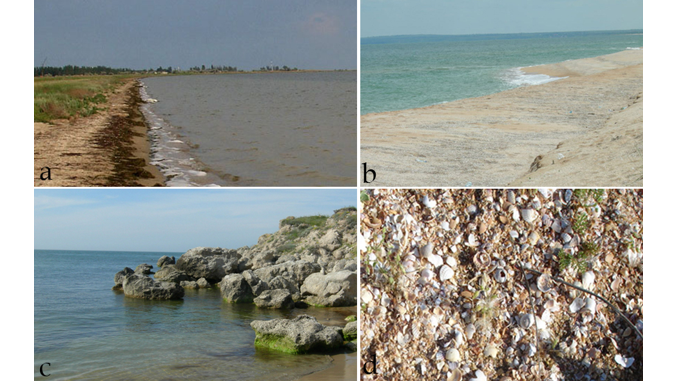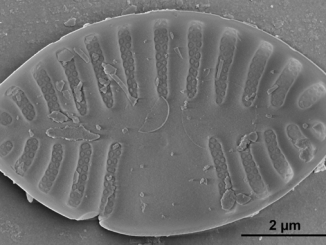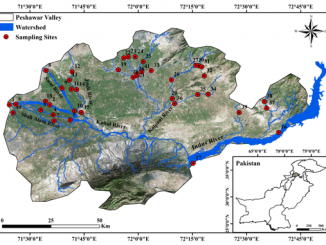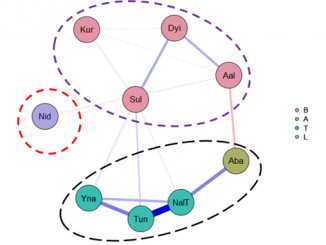
Paper category: Original research paper
Corresponding author: Sophia Barinova (barinova@research.haifa.ac.il)
DOI: 10.2478/ohs-2019-0013
Received: 07/11/2018
Accepted: 11/01/2019
Full text: here
Citation (APA style): Barinova, S., Bondarenko, A., Ryabushko, L., et al. (2019). Microphytobenthos as an indicator of water quality and organic pollution in the western coastal zone of the Sea of Azov. Oceanological and Hydrobiological Studies, 48(2), pp. 125-139. Retrieved 3 Oct. 2019, from doi:10.1515/ohs-2019-0013
Abstract
Bioindication of organic pollution and seawater quality was carried out for the first time in the western part of the Sea of Azov on the basis of species composition and quantitative characteristics of microphytobenthos. A total of 229 algal samples were collected at 17 sites over the period of 2005–2014 on three different substrates in three areas under study: the Sivash Gulf, the Kerch Strait and Cape Kazantip. In total, 200 taxa of algae were found, which belong to six taxonomic divisions with a predominance of diatoms. Among those, 108 taxa are indicators of substrate, water temperature, salinity, water pH, trophic state, the type of nutrition and organic pollution of water. It has been shown that the most active self-purification of water takes place in communities on stony substrates. The largest number of algae species (50%) occurs in the cleanest waters of the Kazantip Nature Reserve (Water Quality Classes I–II). The species composition of organic pollution indicators in the Sivash Gulf corresponds to waters of Classes III–IV, which are more polluted than those of the Kerch Strait and Cape Kazantip. All the studied areas of the Sea of Azov are cleaner compared to some waters of the Eastern Mediterranean and the Sea of Japan.
Sophia Barinova
Anna Bondarenko
Larisa Ryabushko
Sergey Kapranov
References
Admiraal, W. & Peletier, H. (1979). Influence of organic compounds and light limitation on the growth rate of estuarine benthic diatoms. Brit. Phycol. J. 14(3): 197–206.
Al-Yamani, F.Y. & Saburova, M.A. (2011). Illustrated Guide on the benthic diatoms of Kuwait’s marine environment. Kuwait: Inst. Sci. Research.
Barinova, S. (2011). Algal diversity dynamics, ecological assessment, and monitoring in the river ecosystems of the eastern Mediterranean. New York, USA: Nova Science Publishers.
Barinova, S. (2017). Ecological Mapping in Application to Aquatic Ecosystems BioIndication: Problems and Methods. Int. J. Envir. Sci. Nat. Res. 3(2): 1–7. DOI: 10.19080/IJESNR.2017.03.555608.
Barinova, S., Bilous, O. & Ivanova, N. (2016). New Statistical Approach to Spatial Analysis of Ecosystem of the Sasyk Reservoir, Ukraine. Int. J. Ecotox. Ecobiol. 1(3): 118–126. DOI: 10.11648/j.ijee.20160103.19.
Barinova, S. & Krassilov, V.A. (2012). Algal diversity and bio-indication of water resources in Israel. Int. J. Envir. Res. 1(2): 62–72.
Barinova, S. & Krupa, E. (2017). Bioindication of Ecological State and Water Quality by Phytoplankton in the Shardara Reservoir, Kazakhstan. Envir. Ecol. Res. 5(2): 73–92. DOI: 10.13189/eer.2017.050201.
Barinova, S., Medvedeva, L.A. & Anisimova, O.V. (2006). Diversity of algal indicators in the environmental assessment. Tel Aviv: Pilies Studio Publisher. (In Russian).
Barinova, S.S., Anissimova, O.V., Nevo, E., Jarygin, M.M. & Wasser, S.P. (2004). Diversity and Ecology of Algae from Nahal Qishon, Northern Israel. Plant Biosys. 138(3): 245–259. DOI: 10.1080/11263500400006985.
Barinova, S.S., Medvedeva, L. & Nevo, E. (2008). Regional influences on algal biodiversity in two polluted rivers of Eurasia (Rudnaya River, Russia, and Qishon River, Israel) by bio-indication and Canonical Correspondence Analysis (CCA). Appl. Ecol. Envir. Res. 6(4): 29–55.
Begun, A.A. (2012). Of the state of the marine environment on diatoms of epiphyton macrophytes (Peter the Great Bay, the Sea of Japan). Izvestiya TINRO 169: 1–17. (In Russian).
Begun, A.A. & Ryabushko, L.I. (2010). Bioindication of the state of the marine waters by diatoms in the periphyton of experimental plates. Materials of all-Russian Conf. young scientists and experts dedicated to the 125th anniversary from the birthday of I. I. Mesyacev (Murmansk, 20–25 Oct. 2010). Murmansk: PINRO, pp. 29–32. (In Russian).
Bondarenko, A.V. (2012). Microphytobenthos of three regions of the Ukrainian sector of the Sea of Azov. Marine Ecol. J. 11(3): 25–32. (In Russian).
Bondarenko, A.V. (2017). Microalgae of the benthos of the Crimean coastal waters of the Sea of Azov. Unpublished doctoral dissertation. 03.02.10. Hydrobiology. Sevastopol’: 176 p. (In Russian).
Bondarenko, A.V. & Ryabushko, L.I. (2008). Diatoms of the benthos of the Crimean coastal waters of the Sea of Azov. Modern Problems of Algology and the VII School for Marine Biology. Materials of the International. Sci. Conf. (Rostov-on-Don, June 9–13, 2008), Rostov-on-Don, pp. 61-63. (In Russian).
Bondarenko, A.V. & Ryabushko, L.I. (2010). Species composition and seasonal dynamics of the quantitative characteristics of diatoms benthos of the coastal areas of the Kazantip Nature Reserve (the Sea of Azov). Environmental monitoring systems: International Scientific and Technical Seminar (Sevastopol, 13–17 Sept. 2010). Sevastopol’, pp. 231–237. (In Russian).
Cleve-Euler, A. (1953a). Die Diatomeen von Schweden und Finnland. Teil 2. Bd 4, no. 1. Stockholm: Almqvist & Wiksells Bokrtyckeri AB.
Cleve-Euler, A. (1953b). Die Diatomeen von Schweden und Finnland. Teil 3. Stockholm: Almqvist & Wiksells Bokrtyckeri AB.
Gollerbach, M.M., Kosinskaya, V.I. & Polyansky, E.K. (1953). Determinant of freshwater algae of the USSR. Issue 2. Blue-Green Algae. Moscow: Soviet science. (In Russian).
Guiry, M.D. & Guiry, G.M. (2018). AlgaeBase. World-wide electronic publication, National University of Ireland Press, Galway. Retrieved June 20, 2018.
Guslyakov, N.E., Zakordonets, O.A. & Gerasimyuk, V.P. (1992). Atlas of diatoms benthos in the North-Western part of the Black Sea and adjacent reservoirs. Kyiv: Naukova Dumka. (In Russian).
Khuram, I., Barinova, S., Ahmad, N., Ullah, A., Ud Din, S. et al. (2017). Ecological assessment of water quality in the Kabul River, Pakistan, using statistical methods. Oceanol. Hydrobiol. Stud. 46(2): 140–153. DOI: 10.1515/ohs-2017-0015.
Khuram, I.N., Ahmad, S. Jan, S. & Barinova, S. (2014). Freshwater green algal biofouling of boats in the Kabul River, Pakistan. Oceanol. Hydrobiol. Stud. 43(4): 329–336. DOI: 10.2478/s13545-014-0150-y.
Klochenko, P., Shevchenko, T., Barinova, S. & Tarashchuk, O. (2014). Assessment of the ecological state of the Kiev Reservoir by the bioindication method. Oceanol. Hydrobiol. Stud. 43(3): 228–236. DOI: 10.2478/s13545-014-0137-8.
Krupa, E., Barinova, S., Ponamareva, L. & Tsoy, V. (2018). Statistical mapping and 3-D surface plots in phytoplankton analysis of the Balkhash Lake (Kazakhstan). Transylv. Rev. Syst. Ecol. Res. „The Wetlands Diversity” 20(1): 1–16. DOI: 10.1515/trser-2018-0001.
Krupa, E.G., Barinova, S.S., Amirgaliyev, N.A., Issenova, G. & Kozhabayeva, G. (2017). Statistical approach to estimate the anthropogenic sources of potentially toxic elements on the Shardara Reservoir (Kazakhstan). MOJ Ecol. Envir. Sci. 2(1): 1–8. DOI: 10.15406/mojes.2017.02.00012.
Lewin, J.C. (1953). Heterotrophy in marine diatoms. J. Gen. Microbiol. 9: 305–313.
Lyalyuk, N.M. & Lipnitskaya, G.P. (1997) Phytoneuston the littoral of the Sea of Azov as an indicator of the degree of saprobity of the water area. Questions of bioindication and ecology. Zaporozhye: VPK „Zaporizhzhya” RIO, pp. 121–124. (In Russian).
Makrushin, A.V. (1974). Biological analysis of water quality. Leningrad: Zoological Institute RAS Publisher. (In Russian).
Oksiyuk, O.P., Davydov, O.A. & Carpezo, I.Yu. (2010). Microphytobenthos as an indicator of state of water ecosystems. Hydrob. J. 46(5): 75–89. (In Russian).
Proshkina-Lavrenko, A. I. (1963). Diatoms of plankton of the Sea of Azov. Moscow, Leningrad: USSR Academy of Sciences. (In Russian).
Ryabushko, L.I. (2003). Potentially Harmful Microalgae of the Azov and Black sea basin. Sevastopol: EKOSI-Hydrofizica. (In Russian).
Ryabushko, L.I. (2006). Microalgae of the Black Sea benthos (Check-list, Synonyms, Comment). Sevastopol: ECOCI-Gidrofizica. (In Russian).
Ryabushko, L.I. (2009). Microphytobenthos of the Black Sea. Unpublished doctoral dissertation. 03.02.10. Hydrobiology. Sevastopol’, 439 p. (In Russian).
Ryabushko, L.I. (2013). Microphytobenthos of the Black Sea. Sevastopol: EKOSI-Gidrofizica. (In Russian).
Ryabushko, L.I. & Begun, A.A. (2015). Diatoms of Microphytobenthos of the Sea of Japan 2(1). Sevastopol–Simferopol: N. Orianda. (In Russian).
Ryabushko, L.I. & Begun, A.A. (2016). Diatoms of Microphytobenthos of the Sea of Japan (Synopsis and Atlas) 2(1) Sevastopol: PK “KIA”. (In Russian).
Ryabushko, L.I. & Bondarenko A.V. (2011). Microalgae of the plankton and benthos of the Sea of Azov (Check-list, Synonyms, Comment). Sevastopol: EKOCI-Gidrofizica.
Ryabushko, L.I. & Bondarenko A.V. (2016). The Qualitative and Quantitative Characteristics of the Benthic Diatoms near Kazantip Cape of the Sea of Azov. Journal of the Black Sea / Mediterranean Environment 22(3): 237–249.
Saks, N.M. (1983). Primary production and heterotrophy of a pinnate and a centric salt marsh diatom. Marine Biology 76(3): 241–246.
Sládeček, V. (1973). System of water quality from biological point of view. Ergeb. Limnol. 7: 1–128.
Sládeček, V. (1986). Diatoms as indicators of organic pollution. Acta Hydrochem. Hydrobiol. 14(5): 555–566.
Watanabe, T., Negoro, R., Fukushima, G., Kobayasi, H., Asai, K. et al. (1984). Studies on the quantitative water quality estimation nonfresh water pollution using diatom communities as the biological indicator. Ann. Rep. Nissan Sci. Found. 10: 336–341.
Witkowski, A., Lange-Bertalot, H. & Metzeltin, D. (2000). Diatom flora of marine coasts. In H. Lange-Bertalot (Ed.), Iconographia Diatomologica. Vol. 7: Diversity – Taxonomy – Identification.. Ruggell, Köningstein: A.R.G. Gantner Verlag K.G.
Zalat, A.A. (2002). Distribution and origin of diatoms in the bottom sediments of the Suez Canal lakes and adjacent areas, Egypt. Diat. Res. 17(1): 243–266.




Bądź pierwszy, który skomentuje ten wpis